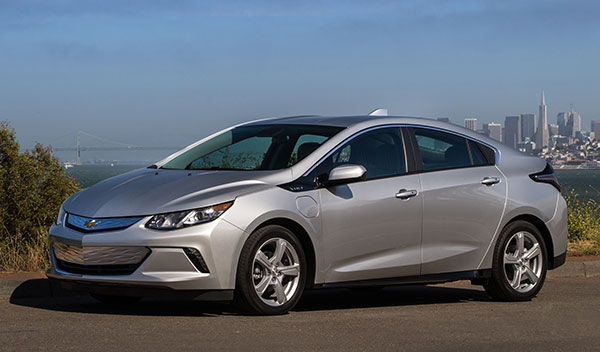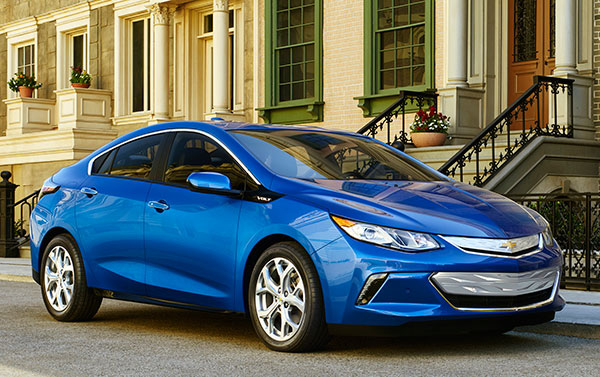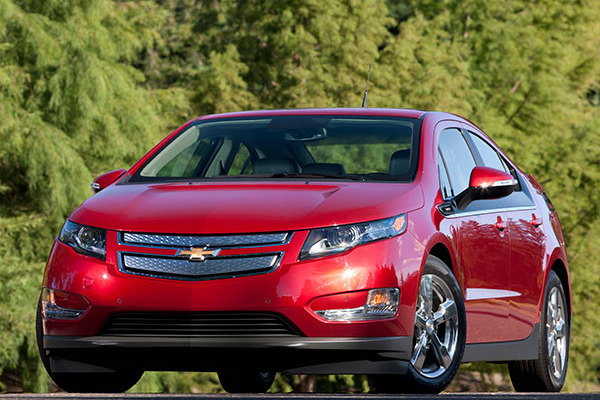

an account. You can:
Access your saved cars on any device.
Receive Price Alert emails when price changes,
new offers become available or a vehicle is sold.


Model Overview of The Chevrolet Volt's For Sale in Middletown, CT
2017 Chevrolet Volt Information
2017 Chevrolet Volt
The Chevy Volt is a sleek and rakish compact hatchback that legitimately offers the best of both worlds: As a plug-in hybrid, it can run totally electric for much of everyday driving, with an EPA-rated range of 53 miles, and switches to gas for longer runs.
Its in the second year of its much improved second generation, and boasts high build quality than what is found on pre-2016 models. Some consumers believe the second year is the sweet spot for a new car, saying any first-year bugs have been worked out while still looking new and sporting the latest technology. The 2017 Volt checks that box.
New Car Test Drive named the Volt Best Commuter Car for 2016.
The only things new for the 2017 Chevrolet Volt are available adaptive cruise control, and a new color. The 2017 Volt only comes as LT and Premier, the latter with more equipment.
The Volt uses two motor-generators to power the front wheels. They get their juice from a lithium-ion battery pack with a capacity of 18.4 kilowatt-hours. One thing different about the Volt from most other plug-in hybrids, is that even under full throttle, it doesnt switch to gas; this means that if you drive it hard under electric power, you wont get that full 53 miles, because it will use up its charge at a faster pace. On the other hand, it isnt burning gas when you dont want it to.
Among plug-in hybrids, that 53-mile range is beaten only by the BMW i3 REx, with 73 miles. But the Volt makes up for it in the gas-driving department, because it has a larger fuel tank and can go farther without refueling, out on the road. The BMW needs to be refueled about every hour, while the Volt can go another 380 miles on its 8.9-gallon fuel tank. Theres almost no comparison anyhow, because the Volt is a real car; the BMW uses a tiny two-cylinder engine that cant always deliver full power.
The Volts internal combustion engine is a 1.5-liter four-cylinder making 101 horsepower. It was a new engine for this second generation, greatly improved. Combined with the motor-generators, the total horsepower is 149 (111 kilowatts), with an impressive 294-pound feet of torque, as much as some V8 pickup trucks. It can accelerate from zero to 60 miles per hour in eight seconds, putting a knowing smile on your face when you pull up beside a Prius at a stoplight. As the light turns green, roll down your window and shout, Put that in your Prius pipe and smoke it!
The Volts combined EPA rating, using both electric and fuel power, is 42 miles per gallon; but thats almost meaningless because its hypothetical and theoretical, based on some average persons combined city-highway driving. An owner who never leaves the city might never spend a penny on fossil fuel. As long as its not below freezing outside. The gas engine might not come on under full throttle, but it does when the outside temperature drops below 32 degrees, using fuel to heat the cabin.
Another rating that applies to plug-in hybrids is Miles Per Gallon Equivalent (MPGe), defined as the distance a car can travel electrically on the energy in a gallon of gasoline, if not that gallon itself. The 2017 Volt hits a strong 106 MPGe.
From depleted, it takes nine to twelve hours to fully charge the Volt, using any household 120-volt outlet and the conveniently located charging cable in the car. Using the optional 240-volt Level 2 charging station, that time is cut to four and one-half hours.
Neither the NHTSA nor IIHS have crash-tested the 2017 Volt, which comes standard with 10 airbags and a rearview camera with sharp resolution. The previous generation Volt earned five stars from NHTSA Top Safety Pick from the IIHS, so we cant imagine this one going backward. Optional safety equipment includes adaptive cruise control, blind-spot monitors, rear cross-traffic alert, lane-keeping assist with lane-departure warning, forward-collision warnings, and automatic emergency braking.
2016 Chevrolet Volt Information
2016 Chevrolet Volt
The 2016 Chevrolet Volt, a five-door fastback hatchback, is all new. Its not like most other cars that are called all-new. With the electric Volt it really is all new, and its important. The first generation of Volt was groundbreaking, and as such had shortcomings. This Volt rewrites the book, in order to cover what was missed in the original.
For starters, it has way more all-electric range, EPA-rated at 53 miles (up from 38); better fuel mileage, EPA-rated 42 Combined miles per gallon (up from 37); and a slightly lower price. In electric mode, the EPA rates the Volt at 106 MPGe (miles per gallon equivalent). An 8.9-gallon fuel tank with the new battery pack give a total gas/electric range of 430 miles, way up from the old Volts 340 miles.
The new Volt is quieter, smoother, and faster: zero to sixty in about 8 seconds, down from 9. Total output to the wheels is the same 111 kilowatts (149 hp), but torque has increased to a remarkable 294 pound-feet from 273.
Its 200 pounds lighter, while seating another person, now five, never mind that it should be a small person. More visibly, the new styling is quite rakish and sporty; instead of sticking out and announcing ELECTRIC CAR, like before, the Volt now turns heads that ask, electric car? (Its actually a hybrid extended-range car, or something like that.)
The cockpit is also less self-conscious, in that it doesnt try so hard to be different. The high-tech chase is toned down, allowing the controls to be more conventional and intuitive. The first Volts irritating touch switches have been replaced by knobs for audio and climate control.
The chassis/platform is also new, to be used by upcoming GM compact cars, for example the next Chevrolet Cruze. Its modified to make space for the Volts T-shaped battery pack. This is the area where improvement is zooming, now with 192 lithium-ion cells, when before there were 288. Battery capacity is 18.4 kilowatt-hours, about 8 percent more.
According to Chevrolet, 90 percent of Volt buyers round trips will be less than 53 miles, so were talking almost never buying gas. But the internal combustion engine is there for the real world, insurance against running out battery power, the elimination of range anxiety. The engine is a 1.5-liter four-cylinder making 101 horsepower, developed to fire on the efficient Atkinson Cycle.
Neither the Insurance Institute for Highway Safety nor the National Highway Traffic Safety Administration have yet rated the 2016 Volt for crashworthiness; the 2015 Volt received five stars (the highest rating), and GM isnt going to let the new one go backward. The 2016 Volt comes with 10 airbags.
2014 Chevrolet Volt Information
2014 Chevrolet Volt
Plug-in hybrids such as the Chevrolet Volt offer the efficiency of an electric car and the certainty of a gasoline engine. The Volt can run on pure electricity, but it carries its own gas-powered generator; so when it runs out of juice, it can keep going. Unlike fully electric cars, it wont leave you on the side of the road wishing for an extension cord.
Volts four-seat, hatchback design makes it a very good all-purpose vehicle, and its electrified powertrain makes for very low operating costs. From the start, we found the Chevrolet Volt fun to drive. However, its initial sticker price made it a pricey investment, even after federal and state tax credits. For 2014, however, the price was lowered about $5,000.
For 2013, a new Hold button allowed the driver to manually choose whether to use the Volts available electric power immediately, or save it for later use. This can help maximize electric range in stop-and-go city driving. The Chevrolet Volt gets an EPA-estimated range of up to 38 miles running on the battery alone. After that, the engine kicks in and youre driving a regular gasoline-powered car.
Options include a moderately priced navigation system that uses Chevrolets MyLink interface, as well as a low-emissions package that gives Volt drivers in California and New York access to carpool and HOV lanes when driving alone. A Comfort Package includes heated front seats and a leather-wrapped steering wheel. The optional Safety Package 1 includes an auto-dimming rearview mirror, rear park assist and rearview camera. Safety Package 2 includes front park assist, forward collision alert and lane departure warning.
At the heart of the Chevrolet Volt is a 111-kilowatt electric motor that puts out the equivalent of 149 horsepower and 273 pound-feet of torque. Its powered by a T-shaped lithium-ion battery mounted under the center console and rear seat. The 435-pound battery has its own heating and cooling system to operate efficiently in extremes of temperature. The Volt will run solely on electricity until its 70 percent depleted; then, a 1.4-liter four-cylinder gasoline engine kicks in to power the electric motor.
The Volt gets an EPA rating of 98 miles per gallon equivalent (MPGe) and 35/40 mpg City/Highway using the gasoline engine.
Anyone who drives less than 30 miles a day should never have to put gas in the Volt. Drivers who can plug it in for charging while at work can double its practical electric range. Drivers who do this say they use so little gas that they have to worry about gasoline going bad in the tank.
Combined with the gasoline engine, the Volt has a total range of about 380 miles. With a 240-volt fast charger, the Volt can fully charge in about four hours. With a regular 120-volt household outlet, the Volt takes anywhere from 10 to 16 hours to charge, depending on temperature.
Driving the front-wheel-drive Volt is really no different from driving any gasoline-powered compact or mid-size car, and the Volt is more energetic and enjoyable than some of them. Its handling is much better than that of the all-electric Nissan Leaf.
Just a couple of years ago, the Volt was the only plug-in hybrid on the market. Thats changed. Fords C-MAX plug-in hybrid offers up to 21 miles in electric mode only, and can go up to 600 miles with a fully charged battery and a full tank of gas. While it cant go as far in pure EV mode, C-MAX offers nearly double the amount of total cargo space. The Toyota Prius plug-in, priced below $30,000 for 2014, has the most cargo space of the bunch, but a far shorter all-electric range.
Volt and other plug-in hybrids qualify for a federal rebate, plus additional credits in some states.
2013 Chevrolet Volt Information
2013 Chevrolet Volt
Plug-in hybrids such as the Chevrolet Volt offer the efficiency of an electric car and the certainty of a gasoline engine. The Volt can run on pure electricity, but it carries its own gas-powered generator, so when it runs out of juice, it can keep going. So unlike fully electric cars, it won't leave you on the side of the road wishing for an extension cord.
The Volt's four-seat, hatchback design makes it a very good all-purpose vehicle, and its electrified powertrain makes for very low operating costs. And we found the Volt fun to drive. However, its sticker price makes it a pricey investment up front, even after federal and state tax credits.
The 2013 Volt gets some improvements and additional features. Previously, the Volt automatically allocated its electric power depending on driving mode and style. For 2013, a new Hold button allows the driver to manually choose whether to use the Volt's available electric power immediately, or whether to save it for later use. This can help maximize electric range if the driver saves the electricity for stop-and-go city driving. The 2013 Chevrolet Volt also gets an EPA-estimated increase of three more miles on electric charge, to 38 miles. After that, the engine kicks in and you're driving a regular gasoline-powered car.
Options for 2013 include a new, lower-priced navigation system that replaces the old system and uses the Chevy MyLink interface, as well as a low-emissions package that gives Volt drivers in California and New York access to carpool and HOV lanes when driving alone. A new Comfort Package includes heated front seats and a leather-wrapped steering wheel. The optional Safety Package 1 includes an auto-dimming rearview mirror, rear park assist and rearview camera. Safety Package 2 includes front park assist, forward collision alert and lane departure warning.
At the heart of the Chevrolet Volt is a 111-kilowatt electric motor that puts out the equivalent of 149 horsepower and 273 pound-feet of torque. It's powered by a T-shaped lithium-ion battery mounted under the center console and rear seat. The 435-pound battery has its own heating and cooling system to operate efficiently in extremes of temperature. The Volt will run solely on electricity until it's 70 percent depleted, then a 1.4-liter four-cylinder internal-combustion engine kicks in to power the electric motor.
The Volt gets an EPA rating of 98 miles per gallon equivalent (MPGe) and 35/40 mpg City/Highway using the gasoline engine.
Anyone who drives less than 30 miles a day should never have to put gas in the Volt, and drivers who can plug it in and charge it up while at work will double its plug-in range. We've talked to a number of drivers who do this and they say they use so little gas that they have to worry about it going bad in the tank.
Combined with the gasoline engine, the Volt has a total range of about 382 miles. With a 240-volt fast charger, the Volt can fully charge in about four hours. With a regular 120-volt household outlet, the Volt takes anywhere from 10 to 16 hours to charge, depending on temperature.
Driving the front-wheel-drive Volt is really no different than driving any gasoline-powered compact or mid-size car, and the Volt is more energetic and enjoyable than some of them. Its handling is much better than that of the all-electric Nissan Leaf.
Just a couple of years ago, the Volt was the only plug-in hybrid on the market. That has changed. Ford's C-MAX plug-in hybrid offers up to 21 miles in electric mode only, and can go up to 620 miles with a fully charged battery and a full tank of gas. While it can't go as far in pure EV mode, C-MAX offers nearly double the amount of total cargo space, and a price tag that's about $6,000 lower. The Toyota Prius plug-in is also less expensive with the most cargo space of the bunch, but it only offers a six-mile all-electric range.
Volt and other plug-in hybrids qualify for a federal rebate, plus additional credits in some states.



